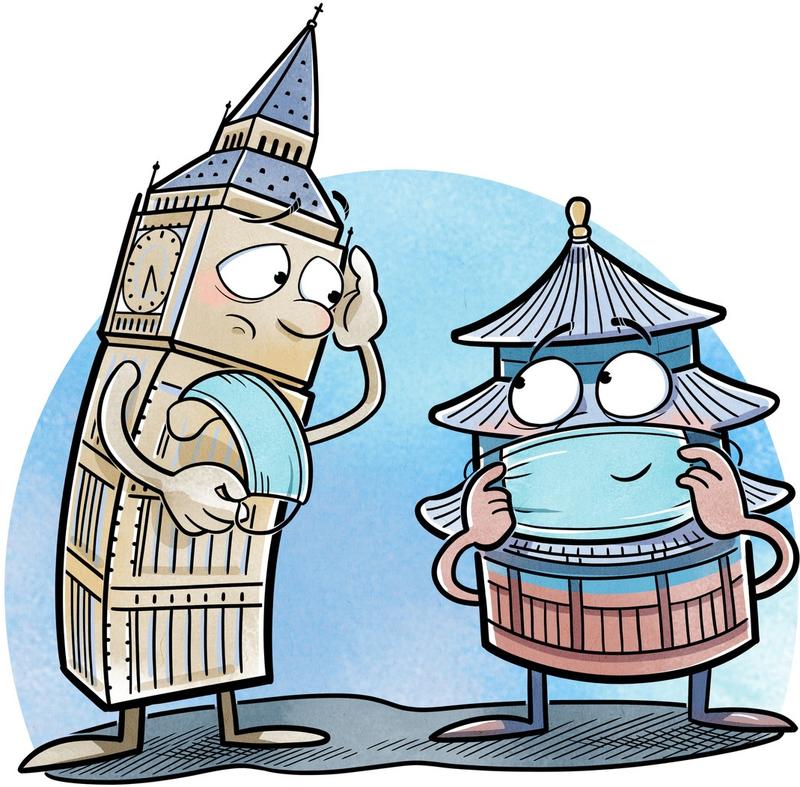 (SONG CHEN / CHINA DAILY)
(SONG CHEN / CHINA DAILY)
The United Kingdom implemented the second round of national lockdown in November 2020 and the third round in January 2021. Unfortunately, the lockdowns in the UK have not been as effective as those in China. Unlike China, for example, the lockdowns in the UK have caused major disruptions, intensified people's anxiety, and increased uncertainties.
On Jan 4, almost two months after the second lockdown, the UK, after analyzing what worked and what did not during the previous lockdowns, implemented the third round of lockdown. This time the lockdown came with the guideline, "national lockdown: stay at home". Different from China, the UK's lockdowns are seen as a set of guidelines.
The past two lockdowns were marked by the lack of control on people's mobility within regions, as was the case during the tiered-system lockdown at the height of the pandemic earlier last year. There was also a lack of decisive actions, which are needed to make the response consistent. In fact, people's movements within regions couldn't be strictly controlled-even today some people are travelling from one city or region to another. For instance, residents of a city or district placed in a higher tier could previously visit their neighboring areas to attend regular public activities.
In contrast, China efficiently managed these issues, which helped it to largely contain the spread of the novel coronavirus in the country and resume normal economic activities.
As for decisive actions, they have remained inconsistent in the UK's action plans and increased the risks of novel coronavirus infections since its early days. On the other hand, China took decisive actions right from the beginning.
The UK's measures to contain the pandemic also fall short when it comes to the advisory on wearing of face masks, maintaining social distance, and restricting people's movements, which became common practice among the Chinese people very early last year.
Besides, during the lockdowns in the UK, the same mistakes appear to have been repeated, with a major one being undermining the anti-pandemic measures by calling the measures "guidelines", because the term has a much softer tone and effect than "restrictions". And despite allowing people's movement for necessary requirements, the authorities didn't even specify what constitutes necessary requirements: "seeking medical treatment", "going to work", or "taking a walk".
On the operational level, such open-end rules can only be seen as a set of equivocal guidelines. While these guidelines focus on day-to-day operations of providing goods and services, securing public services, and maintaining some of the primary activities, we see some inconsistency in safety maintenance across the board. For instance, during the second lockdown, many universities and colleges assigned to lead the response to the virus saw exponential increase in the number of infections on their campuses.
Also, some educational institutions struggled to provide necessary support for their students and staff. Although this shortcoming has been corrected during the third lockdown, many liabilities still overshadow the education sector.
The story was different in China, because experts assessed all the possible risks before working out the response plan which helped the authorities to respond to sector-based needs.
Moreover, people have perceived the different rounds of lockdown in the UK differently. For instance, being more aware of the social, psychological, economic and health impacts of breaking lockdown rules by the time the second lockdown was implemented-and the mutation of a new strain of the virus-the authorities imposed more and stricter restrictions during the Christmas and New Year holidays to control the spread of the virus.
Yet, unlike China, the UK's restrictions have not been all-inclusive or strictly reinforced. For example, the third national lockdown comes with a "fixed penalty notice".
Different from the second lockdown and the Christmas holiday restriction measures, the added dimension of fining people for breaking the rules, seems to be working better in terms of restricting people's mobility. Compared with the first two lockdowns, the current phase highlights control measures more than before, but it is still much less than what China did in terms of implementing a lockdown.
While many countries have already started the vaccination program, the complex mix of lockdowns, a new virus strain, and increasing cases has led to a chaotic global situation that requires more than just a set of guidelines. As it stands, the UK may be stuck with ambiguous lockdown measures leading to more uncertainty in the next few months. We have to realize the longer this continues, the longer we have to deal with the aftermath of the pandemic. Something China took into consideration right in the beginning.
Until the UK vaccinates about 70 percent of its population, it may struggle to come out of the cycle of sporadic lockdowns. But if the majority of the people comply with the lockdown measures for only a few weeks, as happened in China, the UK as well as other countries could also contain the epidemic.
However, for that the current UK guidelines must become a set of augmented restrictions-similar to China's successful model of lockdown.
The author is a professor at and head of the Department of Architecture and Built Environment at the University of Nottingham Ningbo China. He is also the author of the first published full monograph related to the topic of COVID-19, titled "The City in Need".
The views don't necessarily reflect those of China Daily.



